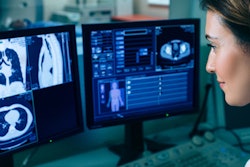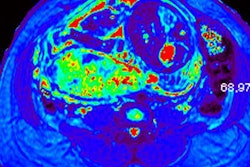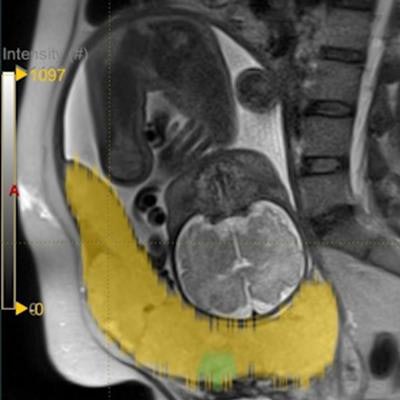
Apparent diffusion coefficient (ADC) MRI values are an important potential marker for the future evaluation of placenta accreta spectrum (PAS) and can help boost confidence in the radiological diagnosis, researchers from Sheffield have reported at the virtual UK Imaging & Oncology Congress (UKIO 2021), which begins today.
ADC and texture may help predict the severity of placental invasion, but these measurements must be combined with other MRI signs and more work is required to assess predictability and reliability, according to Hiba Alessa, a PhD student in the Academic Unit of Reproductive and Developmental Medicine, Department of Oncology and Metabolism, University of Sheffield. Her co-author was Dr. Elspeth Whitby, a clinical senior lecturer in the same department.
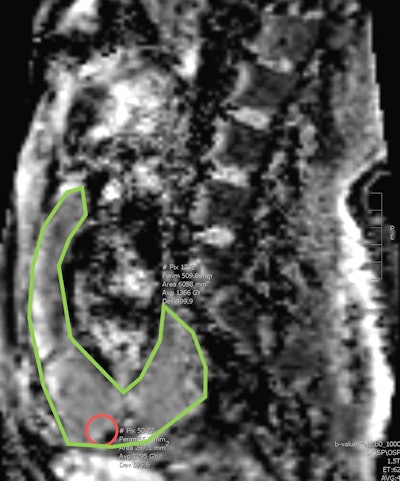 ADC MRI of a sagittal section shows areas of whole placenta segmentation (marked in green) and a small area of regional segmentation (red circle). Figures courtesy of Hiba Alessa and Dr. Elspeth Whitby.
ADC MRI of a sagittal section shows areas of whole placenta segmentation (marked in green) and a small area of regional segmentation (red circle). Figures courtesy of Hiba Alessa and Dr. Elspeth Whitby.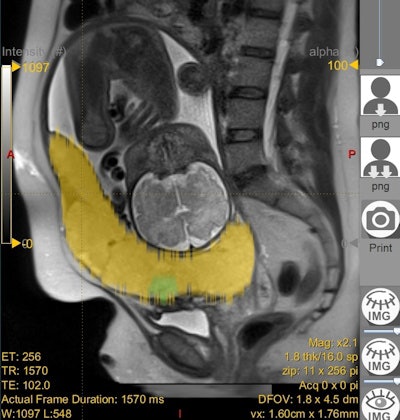 Placenta textural analysis of the entire and regional area of the placenta.
Placenta textural analysis of the entire and regional area of the placenta.PAS -- or abnormally invasive placenta -- causes around 7% of maternal mortalities and is an obstetrics emergency and a leading cause of life-threatening bleeds. Identifying signs of invasion on MRI, such as heterogeneity and dark bands, depends on the expertise and skills of radiologists, so it is vital to develop an objective approach, Alessa told AuntMinnieEurope.com in a precongress interview.
The use of radiomics can give a clue into the micro-structural features, as significant differences have been found between normal and abnormal placental disorders, she noted.
The study logistics
MRI signs have been used by radiologists to diagnose PAS, but Alessa and Whitby wanted to develop a quantitative approach that is objective and not operator dependent. Therefore, they conducted a retrospective study of 200 pregnancies referred to the Sheffield Teaching Hospitals NHS Foundation Trust. The reason for referral was an abnormal ultrasound scan in pregnancies with previous cesarean deliveries.
In the study, the gestational age ranged from 21 to 38 weeks. Images were analyzed by two radiologists. The definitive diagnosis of placental invasion was made based on the pathology results. Not all cases were treated in Sheffield, and a total of 152 patients were included in the analysis. A total of 45 cases were abnormal with placental invasion of different severities, and there were 107 cases with normal placental pathology. Thirty-nine cases were excluded due to poor image quality or missing ADC sequences.
The approximate time frame was from November 2011 to February 2020, and most of the MRI scans were performed on one of two 1.5-tesla scanners from Siemens Healthineers (Magnetom Aera and Avanto machines) located in Sheffield.
ADC values were obtained from the area above the bladder and the entire placenta on a midline sagittal image by two readers. Heterogeneity of the placenta and placental dark bands were also noted. A pathological diagnosis was obtained from the medical records. Texture study of a sample size of 33 images was also analyzed using a radiomics program (LIFEx) by a single reader.
What were the key findings?
The main results, presented in a poster at UKIO 2021, were as follows:
- Total placental ADC was higher in abnormally invaded placentas.
- The whole placental ADC with widespread heterogeneity expressed a higher ADC value compared with homogeneous and local heterogeneous placentas.
- The degree of placental invasion showed a correlation with total placental texture.
- Normal placentas had lower texture values, while placenta increta had the highest level.
- ADC of the total placental area showed a higher value when dark bands were present.
"Although none of our results are statistically significant, the reason behind this is the lack of sufficient abnormal placenta groups. Our results show a trend in texture and ADC in comparison to abnormal cases," the authors stated.
Overall, the regional placental ADC had an agreement with no potential bias between the two readers, they added.
"Some of our results were expected in terms of justifying the findings based on placenta physiology," said Alessa. "As ADC reflects the tissue density, the more the placenta is invaded, the highly vascularized and less dense tissue is there."
Previous applications of radiomics to analyze tissue texture have shown a correlation with some types of breast and brain tumors, but few study groups have looked closely at the placenta. "We were hoping that the ADC value would be related to texture and pathology as it will be clinically easier and quicker to measure ADC than to do a detailed textural analysis," she said.
Looking ahead
Placental invasion is still a rare but important condition, with a high maternal morbidity and mortality, but it is difficult to diagnose, explained Alessa.
"Ideally, experts will be involved in the patient's care, but these experts are located in a few central hospitals. If the diagnosis can be made easier by the use of markers to support the radiologist's impression, then we can use these to select the patients to refer for specialist care and be confident that the other patients are safe to deliver in their local hospital," she commented.
Further work is now required, and a large multicenter prospective study is being planned. More studies to test the correlation between placental texture and ADC values are undergoing. She admits their sample size was relatively small and that was the main limitation, and the researchers now want to collect more placenta invasion cases.




